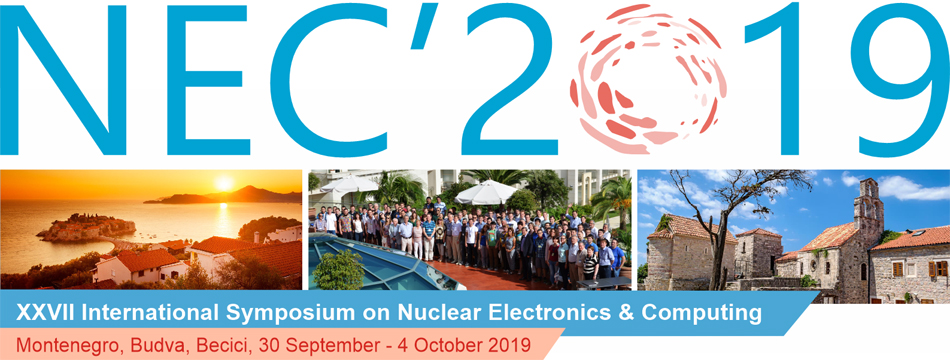Conveners
Distributed Computing. GRID & Cloud computing
- Alexander Kryukov (SINP MSU)
Distributed Computing. GRID & Cloud computing
- Tatiana Strizh (JINR)
Ivan Sapozhkov
(RSC)
01/10/2019, 15:00
Dr
Tatiana Strizh
(JINR)
01/10/2019, 15:40
Distributed Computing. GRID & Cloud Computing
Sectional
The JINR grid infrastructure is represented by the Tier1 center for the CMS experiment at the LHC and the Tier2 center. The grid center resources of the JINR are part of the global grid infrastructure WLCG (Worldwide LHC Computing Grid), developed for LHC experiments. JINR LIT actively participates in the WLCG global project. The work on the use of the grid infrastructure within the WLCG...
Dr
Nikolay Kutovskiy
(JINR)
01/10/2019, 16:30
Distributed Computing. GRID & Cloud Computing
Sectional
The JINR cloud grows not only in terms of the amount of resources, but also in the number of activities it is used for, namely, COMPASS production system services, a data management system of the UNECE ICP Vegetation, a service for disease detection of agricultural crops through the use of advanced machine learning approaches, a service for scientific and engineering computations, a service...
Andrey Chupakhin
(Lomonosov Moscow State University)
01/10/2019, 16:45
Distributed Computing. GRID & Cloud Computing
Sectional
HPC-as-a-service is a new cloud paradigm that represents easy to access and use cloud environments for High Performance Computing (HPC). This paradigm has been receiving a lot of attention from the research community lately since it represents a good tradeoff between computational power and usability.
One of the key drawbacks associated with HPC clouds is low CPU usage due to the network...
Mr
Igor Pelevanyuk
(JINR)
01/10/2019, 17:00
Distributed Computing. GRID & Cloud Computing
Sectional
Computing clouds are widely used by many organizations in science, business, and industry. They provide flexible access to various physical computing resources. In addition computing clouds allows better resource utilization. Today, many scientific organizations have their own private cloud used for both: hosting services and performing computations.
In many cases, private clouds are not 100%...
235.
Accelerating personal computations with HTCondor: generating large numbers of events with GENIE
Mr
Nikita Balashov
(JINR)
01/10/2019, 17:15
Distributed Computing. GRID & Cloud Computing
Sectional
GENIE is one of the most popular MC neutrino event generators, widely used in essentially all neutrino accelerator experiments (e.g. NOvA, MINERVA). The tasks related to the development and optimization of the generator itself require creating a large number of events in the shortest possible time, to reduce the overall development time. The usage of large-scale distributed computing...
Mr
Petr Vokac
(Institute of Physics of the Czech Academy of Sciences)
01/10/2019, 17:30
Distributed Computing. GRID & Cloud Computing
Sectional
HTCondor is a very flexible job management system, but for site administrators it is not always easy to come with optimal configuration to fulfill local policies and requirements. Everybody would expect that normal job execution follow fairshare configuration and recent resource usage, but with few additional quite natural requirements like minimum idle resources it can pretty fast become...
Mr
Alexander Avrorin
(INR RAS)
01/10/2019, 17:45
Distributed Computing. GRID & Cloud Computing
Sectional
Baikal-GVD is a deep underwater gigaton-volume neutrino telescope currently under construction in Lake Baikal.
The detector is a spatially distributed lattice of photomultipliers, designed to register Cherenkov radiation from the products of neutrino interactions with the water of the lake.
When the trigger conditions are met, digitized photomultiplier waveforms are sent the shore, allowing...
Mr
Artem Petrosyan
(JINR)
01/10/2019, 18:00
Distributed Computing. GRID & Cloud Computing
Sectional
Implementation of COMPASS data processing in the distributed environment has started in 2015. Since the summer of 2017, data processing system works in production mode, distributing jobs to two traditional Grid sites: CERN and JINR. There are two storage elements, both at CERN: disk-storage EOS for short-term storage and tape-storage Castor for long-term storage. Processing management...
Dr
Alexander Uzhinskiy
(JINR)
01/10/2019, 18:15
Distributed Computing. GRID & Cloud Computing
Sectional
Crop losses are the major threat to the wellbeing of rural families, to the economy and governments, and to food security worldwide. We present a multifunctional platform for plant disease detection (PDDP). PDDP consists of a set of interconnected services and tools developed, deployed, and hosted with the help of the JINR cloud infrastructure. PDDP was designed using modern organization and...
Dr
Alexander Uzhinskiy
(Dr.)
01/10/2019, 18:30
Distributed Computing. GRID & Cloud Computing
Sectional
Air pollution has a significant negative impact on various components of ecosystems, human health and ultimately causes significant economic damage. Air pollution is the fourth-largest threat to human health, behind high blood pressure, dietary risks and smoking. The aim of the UNECE International Cooperative Program (ICP) Vegetation in the framework of the United Nations Convention on...

